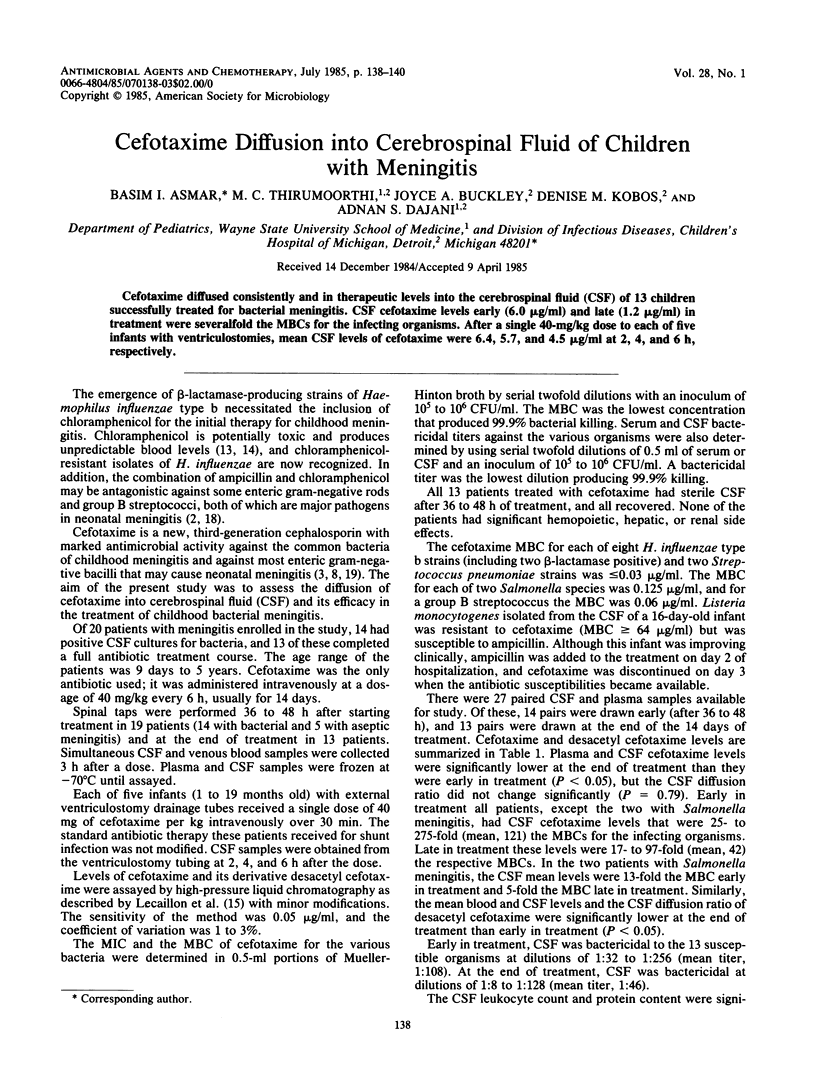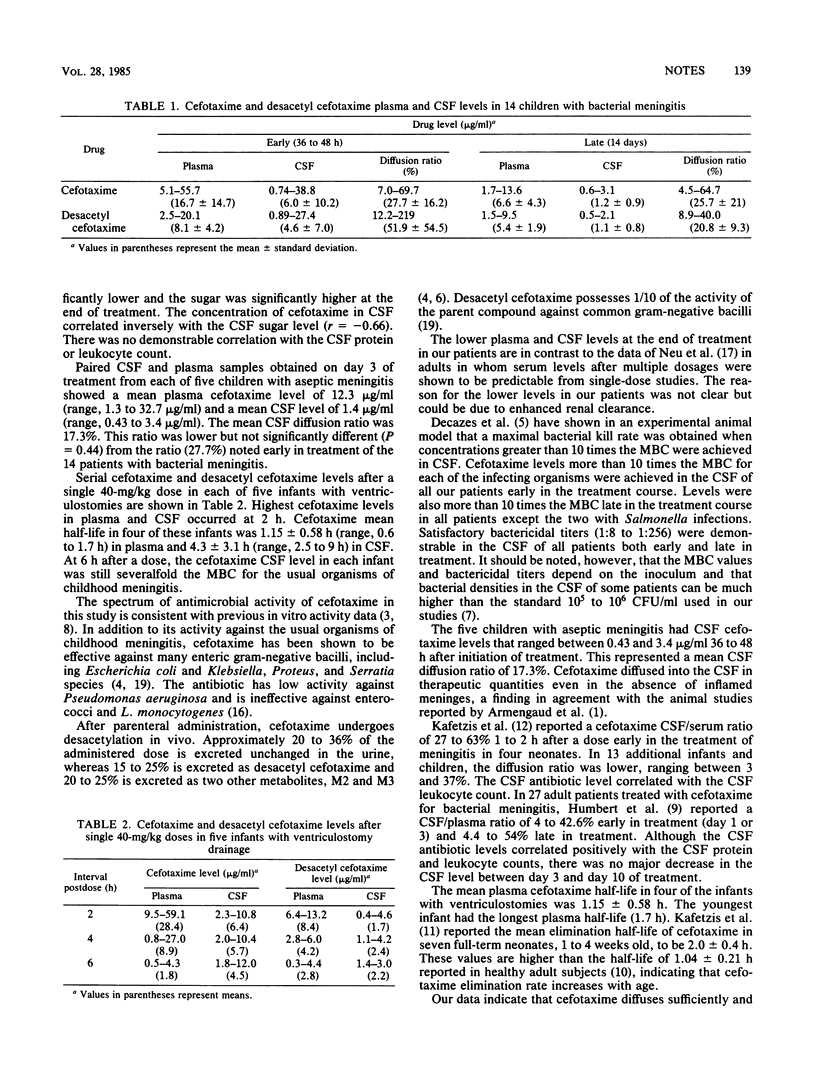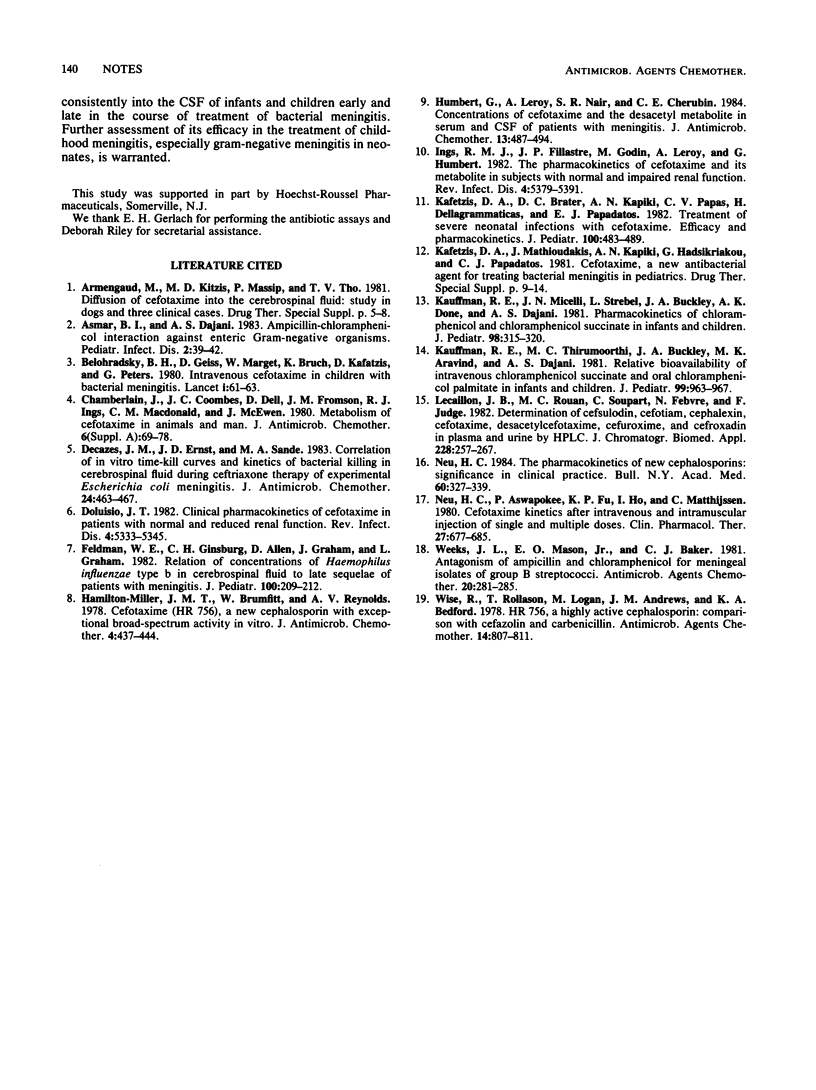Abstract
Cefotaxime diffused consistently and in therapeutic levels into the cerebrospinal fluid (CSF) of 13 children successfully treated for bacterial meningitis. CSF cefotaxime levels early (6.0 micrograms/ml) and late (1.2 micrograms/ml) in treatment were severalfold the MBCs for the infecting organisms. After a single 40-mg/kg dose to each of five infants with ventriculostomies, mean CSF levels of cefotaxime were 6.4, 5.7, and 4.5 micrograms/ml at 2, 4, and 6 h, respectively.
Full text
PDF


Selected References
These references are in PubMed. This may not be the complete list of references from this article.
- Belohradsky B. H., Bruch K., Geiss D., Kafetzis D., Marget W., Peters G. Intravenous cefotaxime in children with bacterial meningitis. Lancet. 1980 Jan 12;1(8159):61–63. doi: 10.1016/s0140-6736(80)90491-2. [DOI] [PubMed] [Google Scholar]
- Chamberlain J., Coombes J. D., Dell D., Fromson J. M., Ings R. J., Macdonald C. M., McEwen J. Metabolism of cefotaxime in animals and man. J Antimicrob Chemother. 1980 Sep;6 (Suppl A):69–78. doi: 10.1093/jac/6.suppl_a.69. [DOI] [PubMed] [Google Scholar]
- Decazes J. M., Ernst J. D., Sande M. A. Correlation of in vitro time-kill curves and kinetics of bacterial killing in cerebrospinal fluid during ceftriaxone therapy of experimental Escherichia coli meningitis. Antimicrob Agents Chemother. 1983 Oct;24(4):463–467. doi: 10.1128/aac.24.4.463. [DOI] [PMC free article] [PubMed] [Google Scholar]
- Feldman W. E., Ginsburg C. M., McCracken G. H., Jr, Allen D., Ahmann P., Graham J., Graham L. Relation of concentrations of Haemophilus influenzae type b in cerebrospinal fluid to late sequelae of patients with meningitis. J Pediatr. 1982 Feb;100(2):209–212. doi: 10.1016/s0022-3476(82)80636-7. [DOI] [PubMed] [Google Scholar]
- Hamilton-Miller J. M., Brumfitt W., Reynolds A. V. Cefotoxime (HR 756) a new cephalosporin with exceptional broad-spectrum activity in vitro. J Antimicrob Chemother. 1978 Sep;4(5):437–444. doi: 10.1093/jac/4.5.437. [DOI] [PubMed] [Google Scholar]
- Humbert G., Leroy A., Nair S. R., Cherubin C. E. Concentrations of cefotaxime and the desacetyl metabolite in serum and CSF of patients with meningitis. J Antimicrob Chemother. 1984 May;13(5):487–494. doi: 10.1093/jac/13.5.487. [DOI] [PubMed] [Google Scholar]
- Kafetzis D. A., Brater D. C., Kapiki A. N., Papas C. V., Dellagrammaticas H., Papadatos C. J. Treatment of severe neonatal infections with cefotaxime. Efficacy and pharmacokinetics. J Pediatr. 1982 Mar;100(3):483–489. doi: 10.1016/s0022-3476(82)80466-6. [DOI] [PubMed] [Google Scholar]
- Kauffman R. E., Miceli J. N., Strebel L., Buckley J. A., Done A. K., Dajani A. S. Pharmacokinetics of chloramphenicol and chloramphenicol succinate in infants and children. J Pediatr. 1981 Feb;98(2):315–320. doi: 10.1016/s0022-3476(81)80670-1. [DOI] [PubMed] [Google Scholar]
- Kauffman R. E., Thirumoorthi M. C., Buckley J. A., Aravind M. K., Dajani A. S. Relative bioavailability of intravenous chloramphenicol succinate and oral chloramphenicol palmitate in infants and children. J Pediatr. 1981 Dec;99(6):963–967. doi: 10.1016/s0022-3476(81)80034-0. [DOI] [PubMed] [Google Scholar]
- Lecaillon J. B., Rouan M. C., Souppart C., Febvre N., Juge F. Determination of cefsulodin, cefotiam, cephalexin, cefotaxime, desacetyl-cefotaxime, cefuroxime and cefroxadin in plasma and urine by high-performance liquid chromatography. J Chromatogr. 1982 Mar 12;228:257–267. doi: 10.1016/s0378-4347(00)80438-7. [DOI] [PubMed] [Google Scholar]
- Neu H. C., Aswapokee P., Fu K. P., Ho I., Matthijssen C. Cefotaxime kinetics after intravenous and intramuscular injection of single and multiple doses. Clin Pharmacol Ther. 1980 May;27(5):677–685. doi: 10.1038/clpt.1980.96. [DOI] [PubMed] [Google Scholar]
- Neu H. C. The pharmacokinetics of new cephalosporins: significance in clinical practice. Bull N Y Acad Med. 1984 May;60(4):327–339. [PMC free article] [PubMed] [Google Scholar]
- Weeks J. L., Mason E. O., Jr, Baker C. J. Antagonism of ampicillin and chloramphenicol for meningeal isolates of group B streptococci. Antimicrob Agents Chemother. 1981 Sep;20(3):281–285. doi: 10.1128/aac.20.3.281. [DOI] [PMC free article] [PubMed] [Google Scholar]
- Wise R., Rollason T., Logan M., Andrews J. M., Bedford K. A. HR 756, a highly active cephalosporin: comparison with cefazolin and carbenicillin. Antimicrob Agents Chemother. 1978 Dec;14(6):807–811. doi: 10.1128/aac.14.6.807. [DOI] [PMC free article] [PubMed] [Google Scholar]


